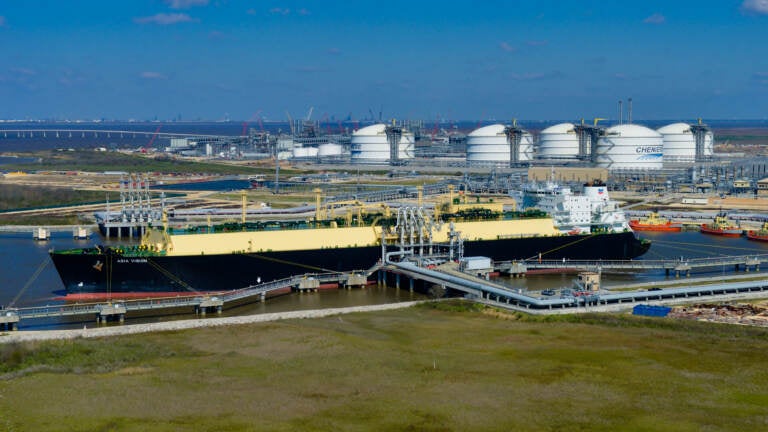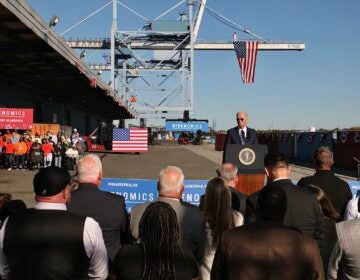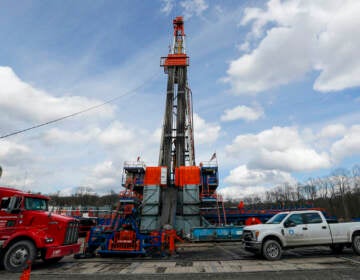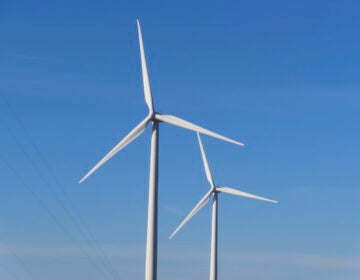Despite their climate pledges, the U.S. and others export huge amounts of fossil fuels

The Asia Vision LNG carrier ship sits docked at the Cheniere Energy Inc. terminal in this aerial photograph taken over Sabine Pass, Texas, U.S., on Wednesday, Feb. 24, 2016. Cheniere said in a statement last month. Cheniere Energy Inc. expects to ship the first cargo of liquefied natural gas on Wednesday to Brazil with another tanker to be loaded a few days later, marking the historic start of U.S. shale exports and sending its shares up the most in more than a month. (Lindsey Janies/Bloomberg via Getty Images)
The U.S. may be on the verge of passing the most consequential climate change legislation ever. President Biden is expected to tout it at a big climate change meeting in Glasgow this week. But that won’t change one of the country’s major sources of greenhouse gas emissions: fossil fuel exports.
The U.S. is among countries that plan to keep exporting oil, natural gas and coal for decades to come even as they work to zero out climate-warming fossil fuel emissions at home. In an increasingly controversial quirk, this is perfectly acceptable under the Paris climate agreement.
Under that deal, countries set targets to reduce their climate-warming emissions. But fossil-fuel exporting countries, including the U.S., Saudi Arabia and Norway, do not have to count emissions produced by their exports. Instead, they are counted by the country that ultimately burns them.
There are calls to bring back a U.S. ban on oil exports
After the oil supply crisis in the 1970s, the U.S. banned crude oil exports for 40 years. A fracking-fueled boom ended production worries and the ban was lifted six years ago in a budget bill. The timing was ironic.
“The ban was lifted in December 2015, actually while many of us were in Paris at the 2015 climate talks,” says Kassie Siegel, senior counsel at the Center for Biological Diversity.
If the U.S. stopped exporting fossil fuels now, says Siegel, they might never get drilled or mined in the first place. She wants President Biden to bring back the export ban.
“The president can declare a national emergency under the National Emergencies Act and then reinstate the crude oil export ban on year-by-year basis,” says Siegel.
Energy Secretary Jennifer Granholm recently suggested that possibility, though more because of high oil prices than climate concerns.
A new ban likely would mobilize the same powerful petroleum industry interests that worked to get the ban lifted in 2015.
“Lifting the export ban has been a real driver in enhancing our energy security, our economic strength, and continuing our energy leadership around the world,” says Frank Macchiarola, senior vice president at the American Petroleum Institute.
Last year, oil shipped to places like China and India brought in about 50 billion dollars and helped reduce the U.S. trade deficit for the first time since records began in 1974.
One French company rejected U.S. gas because of its high climate emissions
Also big business these days is U.S. natural gas exports, about half of which is sent by pipeline to Mexico and Canada. But the fastest growth has been in liquified natural gas (LNG) that’s transported on ships. Asian countries, such as South Korea, China and India, are among the biggest customers.
The LNG business argues that it helps fast-growing economies transition away from dirtier coal, which is more carbon-intensive. Cheniere Energy, the largest LNG exporter in the U.S., points to peer-reviewed research on this.
“Power generated with LNG from the United States, exported, has up to a 57% lower greenhouse gas intensity in China than local coal power,” says Chris Smith with Houston-based Cheniere Energy.
Still, turning natural gas into a liquid requires a lot of energy. It has to be super-cooled to minus 260 degrees. In some cases, an environmental group study shows liquefied natural gas is barely better than coal when it comes to climate-warming emissions. And groups like the Natural Resources Defense Council (NRDC) argue there’s a cleaner option: renewable energy.
“The U.S. can help countries that are still moving to expand electricity – expand energy services – to skip that transition and move straight towards that clean energy future that the U.S. itself is working to achieve,” says Amanda Levin, senior policy analyst at NRDC.
The International Energy Agency says to meet climate goals countries must stop planning for new fossil fuel projects that add harmful emissions. Levin wants federal regulators that approve gas export terminals to apply a climate test, and reject projects that are not consistent with Paris agreement goals.
“I do believe it is possible to pass that test. I do not think most projects would,” she says.
Even without U.S. action, some importing countries are developing climate tests of their own. Last year a French gas company backed out of a deal to buy natural gas from Texas because of the high greenhouse gas emissions associated with drilling and fracking there.
Coal is booming… in Australia
While the U.S. coal industry is in decline, Australia’s coal business is still booming. The country gets 54% of its electricity from coal-fired power plants. That number is declining, but Australia sends almost all of its coal to other countries and those exports are growing.
“Australia is responsible for about 460 million tonnes of CO2 emissions at power plants outside its borders,” says Ryan Driskell Tate, research analyst at the climate data organization Global Energy Monitor. “That’s greater than Australia’s annual CO2 emissions from all fossil fuels.”
That makes Australia a significant contributor to climate change. It’salso a victim of it. The most visible examples were the climate-fueled bushfires nearly two years ago that burned more than 42 million acres, killed 33 people and destroyed more than 3,000 homes.
But those fires barely got a mention last week when Australia’s conservative Prime Minister Scott Morrison finally announced his country’s pledge to zero out greenhouse gas emissions by 2050. Scientists say that’s what’s needed to avoid the worst effects of climate change. Instead, Morrison talked about how addressing climate change will affect the economy.
“Australians want action on climate change and so do I. But they also don’t want their electricity bills to skyrocket. The lights to go off. Or for their jobs to be put at risk,” Morrison said in a recorded video.
Morrison also referred to pressure the United Nations and others put on his administration to move away from coal. “We won’t be lectured by others who do not understand Australia,” he said. “The Australian way is all about how you do it, not if you do it.”
Morrison has a long history of defending the coal industry. Four years ago, as the country’s treasurer, he carried a hunk of coal onto the floor of Parliament for a speech to defend coal mining.
There are scant details on how Morrison plans for Australia to meet its new climate pledge. He says it will be through “technology not taxes.” That may come in for scrutiny at the Glasgow climate talks, known as COP26.
“There’s a huge sense of embarrassment, I think, that Australia is not only not doing enough, but actually going to these global events like COP26 and trying to play a destructive role and… block progress,” says 350.org Australia CEO Lucy Manne.
An idea for a “reverse OPEC” to wind down exports
As leaders meet in Glasgow, some are hoping for a declaration to end burning coal. That would face opposition from both coal exporting nations and those that depend on it for electricity.
Political philosophy professor Jeremy Moss, at the University of New South Wales, has a plan that’s perhaps even less likely; he says exporting countries could limit emissions on their own by voluntarily declining to ship fossil fuels overseas.
“Countries like Australia, or Saudi Arabia or even the U.S. don’t want to take any responsibility,” he says. He proposes a “reverse OPEC” to hold them accountable.
Instead of regulating supply to boost profits, Moss says this would be a “positive cartel” to limit supply and production. “That would send a really clear and strong message to the rest of the world that the fossil fuel age is ending,” he says.
Moss admits such an idea is unlikely to come from the Glasgow climate meeting. Still, he says limiting these climate-warming shipments is a moral question wealthy exporting countries should face.
Even without such moves, change may be coming to Australia. The opposition Labor Party says it plans to make aggressive action on climate change the center of its upcoming election campaign, which must happen before next May.
9(MDAzMzI1ODY3MDEyMzkzOTE3NjIxNDg3MQ001))




